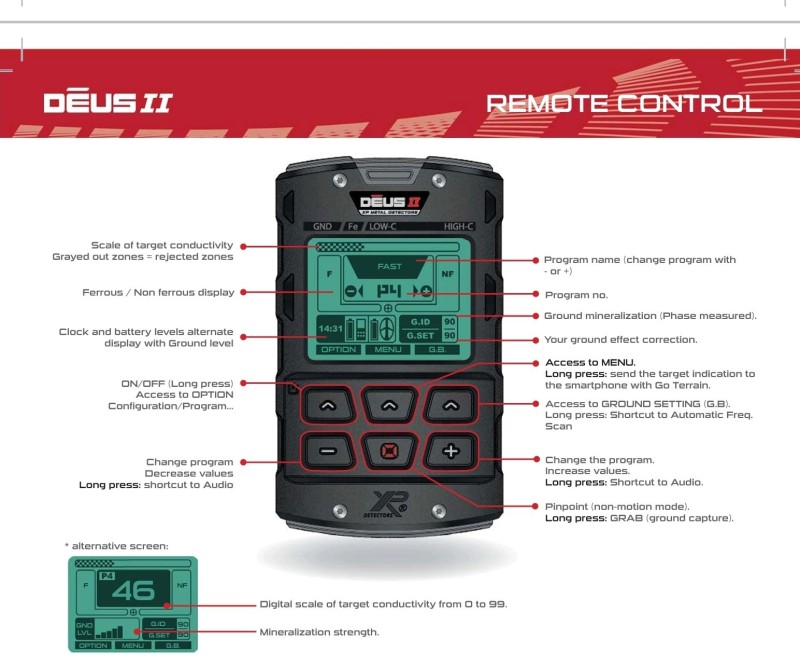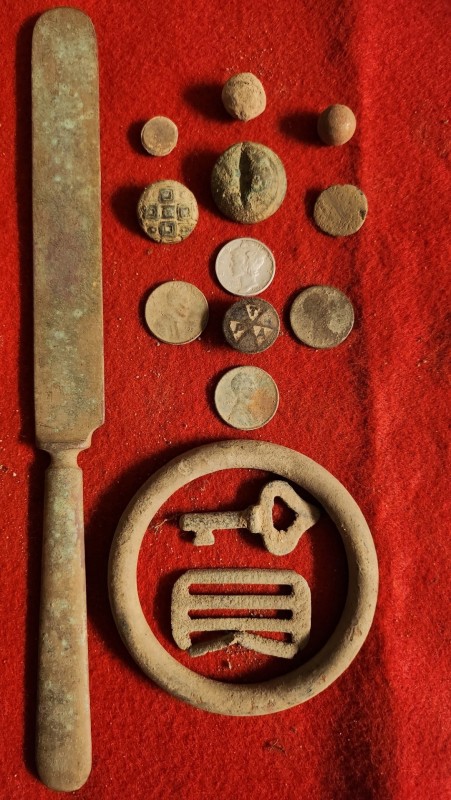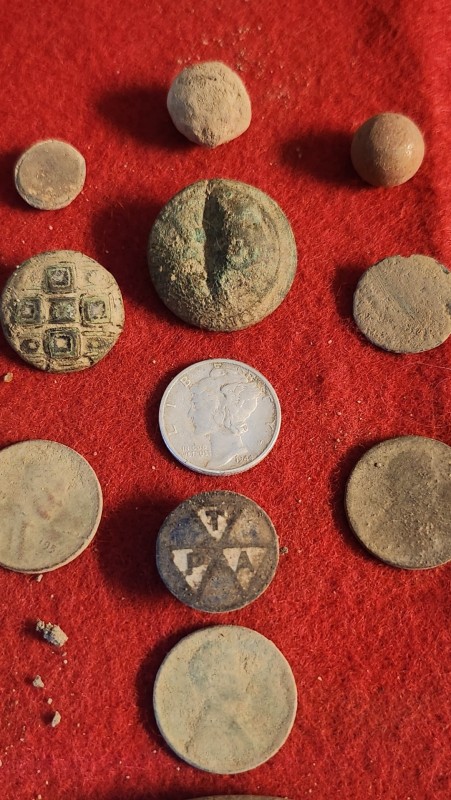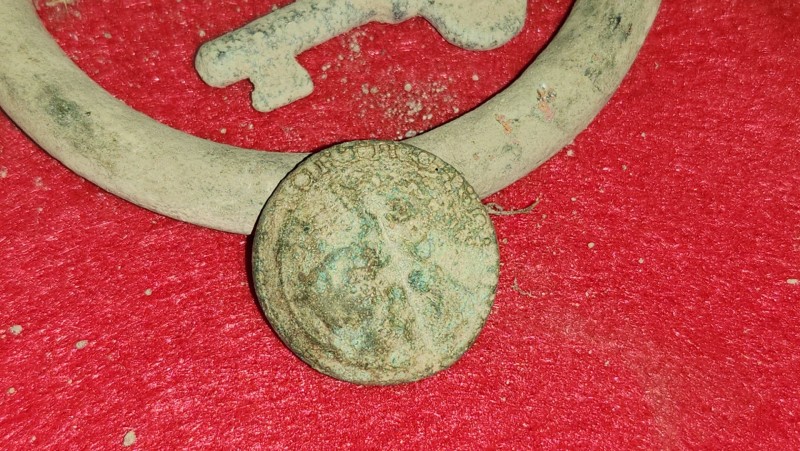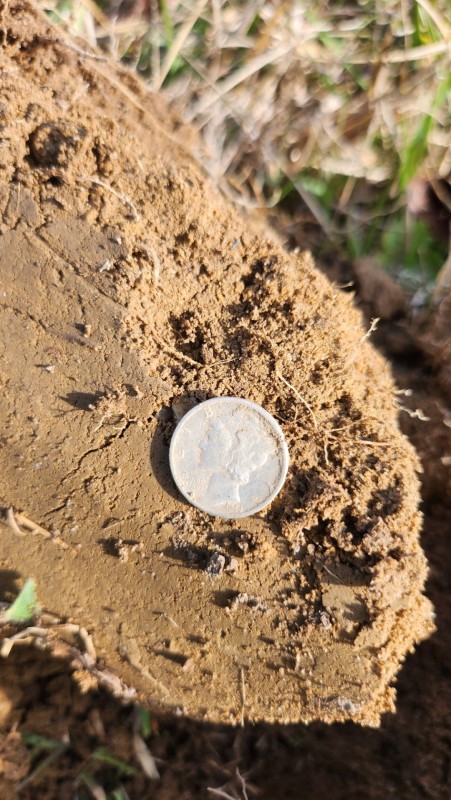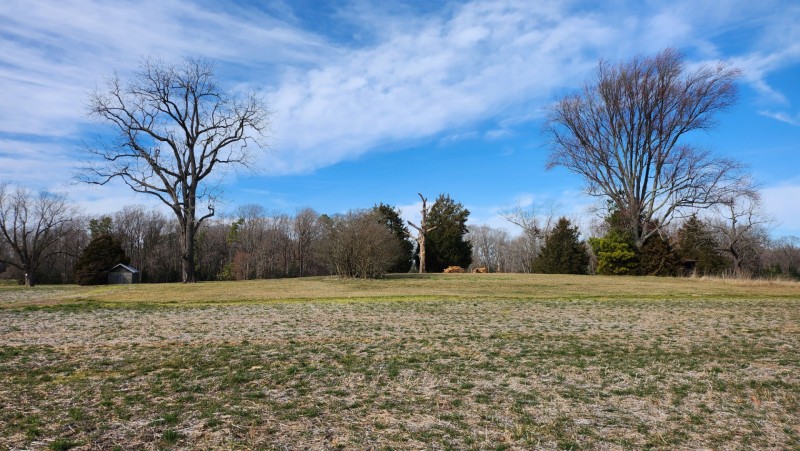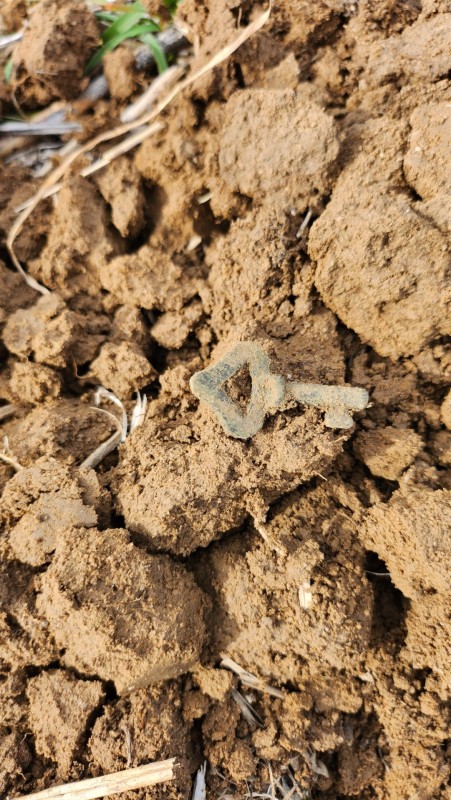-
Posts
6,119 -
Joined
-
Last visited
Content Type
Forums
Detector Prospector Home
Detector Database
Downloads
Everything posted by Chase Goldman
-

A White Black Sand Beach.. Magnet Test..
Chase Goldman replied to Erik Oostra's topic in Detector Prospector Forum
It might be best go with your gut and sit tight, then, and hang on to your money. If it ain't broke, then don't fix it, as they say. You've pretty much got the bases covered with the 800 and D2. Nox 900 will only be an incremental upgrade at best and there may be some downsides beyond having to learn the new nuances. For example, I'm thinking the expanded ID range is a mixed bag - nice to have the expanded mid-range scale but there is a price to be paid with lower ID stability. Hearing good things about the Manticore on the beach (perhaps deeper than Nox) but nothing I have heard indicates it has an advantage over D2 in performance. So if you wait, you can also see how the Manticore saga plays out. So, yeah, there's no real urgency to buy a new model until you have to replace one of your existing detectors.👍 -

A White Black Sand Beach.. Magnet Test..
Chase Goldman replied to Erik Oostra's topic in Detector Prospector Forum
Thanks Eric! Got it. You can then imagine just how much of that black stuff has to be in the soil to generate a mineralization response. BTW What's the status on your Nox 900? -

A White Black Sand Beach.. Magnet Test..
Chase Goldman replied to Erik Oostra's topic in Detector Prospector Forum
Eric - The mineralization strength bar graph is on the main screen (see lower left insert in the figure below) and is separate from the ground balance reading and will tell you the level of black sand mineralization at the beach or site. I suspect it is blank or just showing a bar or two. -

M8 & M15 Coils Price And Availability?
Chase Goldman replied to Ringtail's topic in Minelab Manticore Forum
That's probably just a placeholder price (i.e., not real) for online dealers who are trying to set up pages on their sites for those coils before they are actually released. I've seen this before. I really can't imagine that even ML's US MSRP is THAT high. -

A White Black Sand Beach.. Magnet Test..
Chase Goldman replied to Erik Oostra's topic in Detector Prospector Forum
That is an eye opener when it all concentrates on the magnet like that. But the density of the magnetite in the sand is what determines whether and how your detector will be affected. Unfortunately, the Equinox lacks a mineralization meter even though it does monitor mineralization (black sand) levels to 1) accomplish auto GB tracking and 2) to apply transmit power reductions in beach mode. Do you recall what the Deus 2 mineralization meter shows when you pump the D2 in dry and wet sand? -

M8 & M15 Coils Price And Availability?
Chase Goldman replied to Ringtail's topic in Minelab Manticore Forum
The D2 9" round does great for separation, but sometimes the extra wiggle room of the 10x5 elliptical on the Nox 900 is convenient when working in corn stubble and tight spots. See my posts below on recent recoveries from a Colonial era permission. Many of these relics and coins were recovered using the 9" coil and often it involved machine gun iron in addition to open field hunting. -
Bob and I hit the new permission again. Bob and I focused on areas where his research showed former structures stood and we did pull some relics there including a few old buttons, including one with a neat geometric design, a small brass curio or lockbox key, and a pistol ball. After awhile, we decided to hit the yard area surrounding the old structure's cellar hole. After awhile, Bob met up with the farmer who was tilling the field and while he was doing that, I pulled a brass suspender clip and then a Merc. When Bob returned with 100 more acres in new permissions, I put him on the area of the yard where I just pulled the silver. That is the side where we have pulled the most coins including an 1838 Large Cent I recovered on the last hunt. Bam, he hits a Barber Spill while I work the edge of the foundation. I was pulling mostly shotgun shells and other junk but did manage a "TPA" pin in a hole with 3 wire nails. If the Deus 2 is saying there is non-ferrous and you train your ear to recognize ferrous edge falsing telltales, keep digging the plug because eventually the non-ferrous the D2 was telling you is there, will be found, even if you pull three nails out in the process. After Bob scored his silvers and eventually the Half Cent, I was really forcing it in the machine gun iron to pull some more older coins, and getting a tad frustrated with the toasted wheaties, shotgun headstamps, and more modern round or shallow copper, brass, tin, and steel household items that were blowing my ears off. I did manage to pull the intact copper table knife (it appeared to have been silver plated) and the features dated it to mid-1800's era style cutlery. I threw in the towel after six hours of detecting and we headed back to the vehicles but decided to venture into the middle of the soybean fields away from any known hotspots instead of walking back "as the crow flies", you just never know. Last time we did the walk back I found the brass 18th century pipe tamper in the middle of nowhere. It was mostly silence on the walk back with the occasional iron grunt, then "bam" I hit a banging "92" and was hoping to get my second silver. No such luck... It was much better than that - popped a two-piece CW-era military coat button out of the hole. All I could tell was that it was likely CW and was a little banged up. Cleaning it up at home revealed "North Carolina" around the edge, and my first CW button from the Northern Neck and a relatively rare Confederate Army button at that. That's brass as good as silver in my book. Enjoy the pics and Bob's story.
-
Detecting targets that deep is one thing, recovering it is another. Believe me, unless you are going to actually open up an archeological pit and get on your hands and knees with a trowel and sieve like a professional archeologist, you'll find regularly digging beyond a foot to recover targets to be exhausting after just a couple recoveries. Any of the machines mentioned are have more than enough depth performance for your needs. Focus on value and features and the ability the machine to differentiate and separate treasure from man-made junk (old iron, tin, nails, lead and jacketed bullets and shot, casings, machine and vehicle parts, electrical and plumbing items from old structures, and modern aluminum and other household trash). This is often more important than depth capability. Also, you really do need to check into the local laws and regulations regarding disturbing and recovering artifacts of historical significance on public lands (typically forbidden by law) and it can get complicated even on private lands, especially if they have spiritual significance to indigenous peoples.
-
My Virginia hot dirt relic machine journey: I first started out with a used ATX and my original Deus. The ATX was a tank and I migrated to a second hand GPX 4800. I eventually got an Equinox 800 and then an Orx to backup my Deus. A few years back, I picked up a Tarsacci. It proved itself as a good change of pace hot dirt machine I knew could get it done when the GPX got too heavy on marathon detecting days. The Equinox 800 was iffy in hot dirt. I could get the Deus 1 to work marginally OK in hot dirt in Gold Field mode. But Tarsacci still beat both of them in highly mineralized soil. However, the level of tweaking, tuning, and basically black magic guesswork required was a lot for something that was at the end of the day just a ferrous go/no go machine with less depth than a PI and that I could never get to work well unmasking in machine-gun iron and was a nightmare in modern non-ferrous trash. Along came the D2. I am adept now at working my D2 in just about all situations. No, it will not go as deep as the Tarsacci in hot soil, but it will go deep enough, is light weight, can move seamlessly from wide open fields, to picking its way through in high target density situations to unmask keepers whether it's in Machine gun iron, can slaw hell, or a combination of both. I personally have no issues with it for light duty beach and water hunting but understand its limitations and hassles for dedicated, hard-core water hunters and for those that have to reconfigure the antenna claptrap going from land to water. I have the luxury of having a dedicated beach/water variant with SteveG's excellent CF shaft system, but obviously that is not an option for most due to cost. I embrace the advantages of XP's modular wireless platform - multiple "lite" configuration options that can enable instant backup detectors for guests or if a component fails in the field or on a trip. The ability to hold the coil/lower shaft in your hand to scan the vertical wals of a cellar hole, hut, or pit like a pinpointer on steroids that can provide target IDs. My main complaint - no compatible 10x5 coil variant for the D2 like that which was available on the D1. I upgraded to the Nox 900 because the improvements over the 800 were worth it IMO, especially the improved ergonomics and the deep pitch audio option for all modes (not just Gold). Having a little bit of an issue with Target ID stability with the expanded scale and some odd EMI issues on the 900, but unless XP comes out with a 10x5 coil for the D2, I'm hanging on to the 900 for now to backup the D2 and feel the Manticore is simply redundant to the D2/900 combo, and even then has some shortcomings. I am also trying to see if I can finally bond with the Legend now that it has small elliptical coils. Legend will serve as a second backup as it seems more EMI immune than the 900 and has some features even the 900 still doesn't have (mineralization meter, more sophisticated/adaptable filtering, and now 3 MF profiles per Park/Field modes vs. the Nox's 2). Its software is being actively upgraded and its also $1000 less than Manticore and the non-light variant of the D2 (a fact which cannot be ignored) making it perhaps the best value around. At the end of the day I feel the ground (hot or mild) is just more transparent when I'm swinging the D2 for coins and relics. Especially in Relic mode which is my primary search mode. I can hear and process every grunt, zip, and whisper. I have set up custom configurations of 3 of the "discrimination" base programs (General, Sensitive/Fast, Deep HC) to somewhat emulate relic mode by using pitch target audio and use those to sometimes interrogate iffy signals encountered by Reluc mode. Next up will likely be the Axiom which might just finally obsolete my Tarsacci and perhaps the GPX as well.
-
I agree that out-of-the-box/DOA issues for "established" detector models (e.g. the CTX or Nox 600/800's, etc.) should typically be handled by the dealer as an exchange from dealer on hand inventory. But I know for a fact that ML keeps a short leash on dealers with newly released ML detector models such as the Nox 700/900 and Manticore. ML requires dealers to instruct buyers to deal directly with ML North Americas Detector Center Support in Naperville, IL. In fact, the ML repair facility is seldom involved during this phase as ML Support in Naperville typically handles the exchanges directly. The reasons are because: 1) ML HQ wants a detailed accounting of these "infant mortality" failures to determine root causes (e.g. design flaw, manufacturing flaw, material defect, shipping damage) so that corrective actions can be quickly developed and implemented and 2) the dealers and ML repair centers typically do not have replacement stock on hand to deal with these early phase issues. I had a defective pushbutton on.my brand new Nox 900 and went through the replacement process. Since it was within 30 days of purchase they said I was entitled to a brand new in box unit so I shipped the defective unit and all accessories back in the original box and upon receipt they sent me the new one. I detailed the process here. FWIW
-

Phew, Finally Got My Coil Replaced..
Chase Goldman replied to Erik Oostra's topic in Metal Detector Advice & Comparisons
I hope I’m wrong too, but the only evidence of a an ear upgrade are the 11” coils included in the 700 and 900 kits that now have threaded ears. I agree with you it makes no sense…. Not sure if the new improved 11” coils are compatible with the legacy 600/800 Nox lower rods. I know the legacy 6”, and Nox 10x5 coils are compatible with the Nox 700/900 lowers, however. Also not sure what you get if you order an 11” coil as a standalone replacement…. This is what happens when Minelab just sort of slips that in under the radar unannounced (so they never have to explicitly admit to an inferior design), I am not sure how they manage configuration of the standalone stock of accessory coils. There is no mention of a 700/900 variant vs. the 600/800 legacy accessory coils on their website. BTW, the ordeal you went through just to get your warranty replacement coil is somewhat appalling in terms of how long it dragged on. Glad it’s happening in any event. -

Phew, Finally Got My Coil Replaced..
Chase Goldman replied to Erik Oostra's topic in Metal Detector Advice & Comparisons
Eric - I believe they only redesigned the 11" coil ears for the 900. As far as I can tell, the 6" included with my 900 is the same as the original design and it is not clear the 12x15" coils have been redesigned either but I could be wrong. -

Dimitar Throw The Faithful Few A Bone
Chase Goldman replied to Ridge Runner's topic in Tarsacci Metal Detectors
Moved the last several posts on specific Tarsacci setup tips and tricks to this thread. https://www.detectorprospector.com/forums/topic/21699-tarsacci-cookbook-and-best-practices/ -

Tarsacci Cookbook And Best Practices
Chase Goldman replied to The_Stalker's topic in Tarsacci Metal Detectors
I think it's 28 per the manual, that's the salt beach salt balance starting point per the user manual. -

Tarsacci Cookbook And Best Practices
Chase Goldman replied to The_Stalker's topic in Tarsacci Metal Detectors
Thanks for this. Not familiar with the fail safe numbers on salt balance, though. I aways start in the mid-40's. -

Tarsacci Cookbook And Best Practices
Chase Goldman replied to The_Stalker's topic in Tarsacci Metal Detectors
I have a Deus 2 and use that 90% of the time, otherwise I'm using a PI in hot dirt. MDT still goes deeper than the D2 in hot dirt and that is the only reason I hang on to it, but I'll go PI first. Everywhere else (beach, park, mild dirt relic, machine gun iron, canslaw infested), the D2 kills it for me. So it's a very niche application where its worth messing with, namely: high iron the PI can't handle in hot dirt where I am going for depth beyond what the D2 can deliver. Thanks. I start with 43 too, it's hard for me to figure how to adjust it from there, though. Not sure how the fertilizer translates to my magnetite hot soils, but it's something. You lost me though when you said with high salt balance the machine gets dull even on low sensitivities. How do you determine that? What is telling you that the machine is getting dull and I don't understand why you would lower sensitivity in response to dullness. -

Tarsacci Cookbook And Best Practices
Chase Goldman replied to The_Stalker's topic in Tarsacci Metal Detectors
Are you talking non-ferrous Trash or ferrous trash? I find it great for differentiating non-ferrous from ferrous at depth in hot dirt, especially using mixed audio. But as a relic hunter, the MDT would be the last machine with which I would venture into an area polluted with aluminum or similar non-ferrous trash due to it's tonal limitations and sub-par ID stability. The thing I struggle with most is how to set up salt balance in hot dirt. It's different than at the beach and I have found no tried and true methodology, it's really hit or miss. Any hints and tips on how you adjusted salt balance settings at hot dirts sites would be appreciated. Regarding the lost nuggets of MDT technical info at Aaron's site, there was also a PDF compendium and summarization of MDT notes cherry picked from threads on Dankowski Detectors. Do a Google search on "Tarsacci MDT 8000 Usage Notes" and it will hit on the Part 1 and Part 2 PDFs you can download and use for future reference. -
Chuck, yeah it is definitely APTX-LL grade which means you can fall anywhere between 20 to 40ms latency also there are sometimes gotchas when mixing and matching these transceivers. For example, I've had transceivers that will transmit in APTX-LL mode no problem but only will receive in non-APTX. It's somewhat hit or miss. Also, pairing these devices "blind" (i.e., without a smart phone display, etc. can be frustrating because it is hard to be sure if they paired up to each other or to some other BT device. That's why I generally only use these Rx/Tx boxes as transmitters, hooked up to the audio source (detector) and use a BT APTX-LL compatible headset. On my Minelab GPX I have moved on from the BT APTX-LL "poor man's" setup and instead have settled on using the Garrett Z-Lynk system to provide wireless audio. It just works and it also allows me to integrate my wireless AT Pro Carrot into the mix. This obviously does not help Gone Bush, but it is what it is. One other proprietary solution I can recommend are the Quest wireless rigs. They also just work, are reliable, weatherproof, cost effective, and low latency. The only thing that gives Z-Lynk the edge for me is the wireless pinpointer integration.
-

New To Detecting, Question About 1 And 2 On Vdi
Chase Goldman replied to Gary985112's topic in Minelab Equinox Forum
I'm not Gerry, Steve, or Andy, but based on my limited experience with the Nox over the past 5 years, I agree that with the Nox disc and notch settings are generally indistinguishable but in my "there are no absolutes in metal detecting" mindset, I cannot say with certainty that discing the ferrous zone will have no adverse effect on a fringe signal that is IDing near that disc setting based on my personal experience. I know that Iron Bias definitely has an impact. My point was really in response to a poster who said disc in modern detectors is basically like a notch...and I just wanted to point out that generalization does not hold true across the board. On Deus and Deus 2 Disc definitely does not equal Notch. Not sure about Legend. On Manticore, I believe the Disc/Notch behaves similar to the Nox. I also wanted to point out that I have seen videos that demonstrate how increasing upper ferrous limits on a Manticore can make a non-ferrous target become masked in the presence of adjacent ferrous targets, so there is definitely an effect there can cause target masking if you overdo it on the ferrous falsing cancellation filter (AKA ferrous limits) - which is really just relearning the lesson from "Filters 101 for Metal Detecting" - bottom line cliche' alert>too much of a good thing can be bad, all settings can have unanticipated adverse consequences, and there are no free lunches. FWIW. -
Yep. It's APTX LL. Don't know if it is available in Oz, though. For hot climes I recommend the Avantree Torus (you can use the ample loudspeaker (it rests on your shoulders, around your neck) or switch to the built-in earbuds) - it is not inexpensive at $90US but it is highly compatible with all BT APTX-LL devices and has great audio fidelity out of the speakers or earbuds. You can definitely plug your earbuds into the recommended Trond transceiver. You can plug a twin into the detector as the transmitter. Total outlay is about $60US plus the cost of the earbuds. For plugging into the detector, I can also recommend the 1Mii transmitter/receiver (similar to the Trond, but with 5.2 compatibility including APTX Adaptive as will as APTX LL) APTX Adaptive is the updated APTX low latency codec that is replacing the obsoleted APTX-LL codec.
-

New To Detecting, Question About 1 And 2 On Vdi
Chase Goldman replied to Gary985112's topic in Minelab Equinox Forum
I agree it’s real. Similar issues arise with Manticore while adjusting its ferrous limits (different than discrimination) and on Deus 2 - Discrimination can affect signal processing and is not just an audio suppression feature as D2 has a separate setting for that called notch. Anyway, just wanted to clarify, however that the effect you are seeing is not a reduction in sensitivity so much as a reduction in unmasking/recovery for those fringe targets. In a practical sense it manifests the same as a perceived loss of sensitivity, but it’s more like cranking reactivity/recovery way up (which clips the target audio response) than turning sensitivity down. FWIW. -

Dimitar Throw The Faithful Few A Bone
Chase Goldman replied to Ridge Runner's topic in Tarsacci Metal Detectors
Dunno if Ditimar will come on, but Dimitar might…😉 Chuck - what about all these other great VLF machines that ARE happening in your lifetime (Nox 700/900, Manticore, Deus 2, Legend, Quest V80…all released or about to be released in just the last year)? You can see where the manufacturers are going and it isn’t single frequency. It’s unfortunately getting harder for Tarsacci to make a splash much less compete…so hopefully Dimitar does have something unique up his sleeve again that can turn some heads away from these established players… -

Can Anyone ID This Relic?
Chase Goldman replied to Capphd's topic in Metal Detecting For Coins & Relics
What's on the other side? -

M8 & M15 Coils Price And Availability?
Chase Goldman replied to Ringtail's topic in Minelab Manticore Forum
You can still do that with the 800/900. Not sure the M-core really brings anything more to the table in that regard, anyway. Now that the 900 comes with a collapsible shaft, I can bring it and the 6" coil along in a day pack while I swing my main rig.


